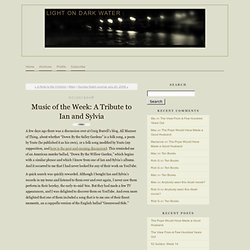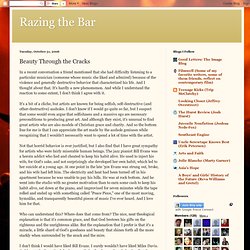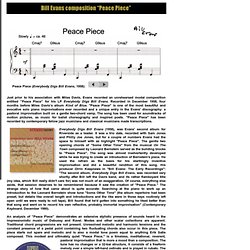

Essential Artists. Musical Primers. Classical. Instruments. Get Music. Music of the Week: A Tribute to Ian and Sylvia - Light On Dark Water. A few days ago there was a discussion over at Craig Burrell’s blog, All Manner of Thing, about whether “Down By the Salley Gardens” is a folk song, a poem by Yeats (he published it as his own), or a folk song modified by Yeats (my supposition, and here is the post and ensuing discussion).

This reminded me of an American murder ballad, “Down By the Willow Garden,” which begins with a similar phrase and which I know from one of Ian and Sylvia’s albums. And it occurred to me that I had never looked for any of their work on YouTube. A quick search was quickly rewarded. Although I bought Ian and Sylvia’s records in my teens and listened to them over and over again, I never saw them perform in their heyday, the early-to-mid ‘60s. But they had made a few TV appearances, and I was delighted to discover them on YouTube. To my taste these two Canadians, Ian Tyson and Sylvia Fricker, were the best of the pop-folk artists of the ‘60s.
Pre-TypePad. Beauty Through the Cracks. In a recent conversation a friend mentioned that she had difficulty listening to a particular musician (someone whose music she liked and admired) because of the violence and generally destructive behavior that characterized his life.

And I thought about that. It's hardly a new phenomenon. And while I understand the reaction to some extent, I don't think I agree with it. It's a bit of a cliche, but artists are known for being selfish, self-destructive (and other-destructive) assholes. I don't know if I would go quite so far, but I suspect that some would even argue that selfishness and a massive ego are necessary preconditions to producing great art. Not that horrid behavior is ever justified, but I also find that I have great sympathy for artists who were fairly miserable human beings. Who can understand this? I don't think I would have liked Bill Evans. Why We Fight: On Beauty, Which Really Does Not Have to Be Dull. I've always been partial to music that is... sedate.

Dreamlike. Cerebral. Contemplative. Soothing. Elegant, stately, pretty, "ethereal," sweatless, tender, "sophisticated," poised, thoughtful, "literate," mood-driven, demure, "mellow. " Of course, I mostly care whether the music I'm listening to is good, and whether it has anything interesting to say. It's funny, though: Most music lovers carry around some shred of a very powerful myth that says the opposite, that pleasant music can never really be where the meaningful ideas are. What we're talking about is a Baby Boomer myth of rock'n'roll.
Now if you happen, like me, to be fond of music that's "sedate" and "contemplative," there will be times when this narrative is a pain in your ass, or a blunt object someone uses to beat you. This year has been a good one for those noises. Beauty can-- and should-- be something you create, not default to. Bill Evans composition Peace Piece. Peace Piece (Everybody Digs Bill Evans, 1958): Just prior to his association with Miles Davis, Evans recorded an unrehearsed modal composition entitled “Peace Piece” for his LP Everybody Digs Bill Evans.

Recorded in December 1958, four months before Miles Davis’s album Kind of Blue. "Peace Piece" is one of the most beautiful and evocative solo piano improvisations ever recorded and a unique entry in the Evans' discography: a pastoral improvisation built on a gentle two-chord vamp. The song has been used for soundtracks of motion pictures, as music for ballet choreography and inspired poets. "Peace Piece" has been recorded by contemporary fellow jazz musicians and classical musicians made transcriptions. Everybody Digs Bill Evans (1958), was Evans' second album for Riverside as a leader. An analysis of “Peace Piece” demonstrates an extensive stylistic presence of sounds heard in the impressionistic music of Debussy and Ravel.
Peace Piece by Jean-Yves Thibaudet: Holiday At The Sea » Blog Archive » Should’ve Known: An Interview with Doug Burr. Great music is everywhere for those with ears to hear.

In other words, you have to be listening. My wife and some of our best friends had the unexpected treat of being as affected by an opening act as the headliner when we went to see local Dallas/Denton singer-songwriter open for Bill Mallonee, formerly of the Vigilantes of Love. Burr thoroughly impressed us all. Plugged says: “If Doug Burr’s not your new favorite singer/songwriter, it’s because you haven’t heard of him yet.” Leaving such hyperbole aside, we recently caught up with Burr on the release of his new album On Promenade to discuss life, art and everything in between: Where and when were you born? Dallas, 1972 Were you raised in a musical home? Not very musical. Lubbock (On Everything) > Overview )))